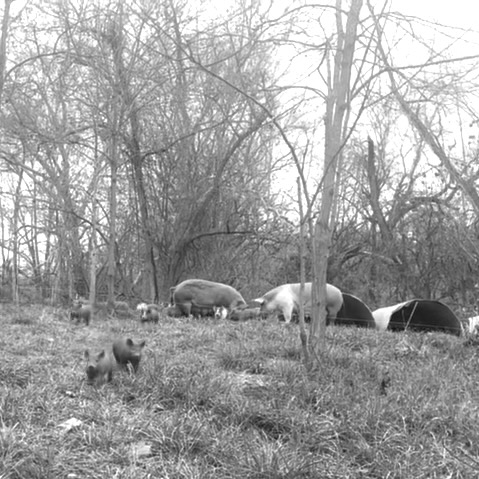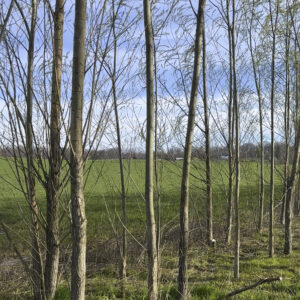At the current moment, almost all pigs in the United States live their entire lives without seeing the light of day. Over 98% of pigs are raised in industrial houses or Confined Animal Feeding Operations (CAFOs). I wish the remaining 2% were all raised on pasture under oak trees, but many of those are on dirt lots or also in barns but with deep bedding to root in. The complete lack of scale of pastured pork, unlike the much more successful rise of grassfed beef, is rather demoralizing if you’re someone who wants to see high animal welfare standards and healthy, abundant ecosystems.
And this is actually an improvement over the status of things, say, 50 years ago. For all of my lifetime, and the entire lifetime of just about everyone still alive on this planet, raising pigs in CAFOs was the standard means of production, and it’s hard to imagine another reality. Many have tried to offer an alternative through production on pasture, but the relatively small intake of pasture doesn’t come close to offsetting the added labor, feed cost (because they tend to operate on a much smaller scale), and reduced economies of scale.
But this current reality is not the default. In historical terms, raising pigs in CAFOs is an anomaly. In fact, for several hundred years, pastured, acorn-and-chestnut-finished pork was the most common, most affordable meat in the country, even more so than beef, and certainly more affordable than chicken. Today we think of acorn-finished hams as some of the most exclusive, most expensive meat in the world, but for a large portion of history, that was what most people ate. That realization alone is a welcome sign to all of us who have no living memory of other days. But the even better part is this: we can recreate that reality.
The reason that pigs finished on mast (the fruits, nuts and pods of trees) was so common for so long is that until the early 1900s, we had millions of acres of freely accessible, high-quality forests in the United States producing billions of pounds of free feed every year in the form of acorns, chestnuts, hickories, beech nuts, persimmons, red mulberries, hawthorns, plums, wild apples and more. As Mark Essig, author of the wonderful book Lesser Beasts points out, we had at that point the perfect conditions for raising pigs in a low-input, low-labor system. Seemingly unlimited amounts of space where pigs could get their own food for free, requiring almost no labor and very little feed other than that used to keep them trained so they’d come when you wanted to catch them. For a young nation with lots of space and short on labor, it was the perfect system.
By the early 1900s though, we’d lost most of that. There are doubtless a host of factors, but one significant one is the loss of the American chestnut due to the chestnut blight, which quickly wiped out the most widespread and reliable producer of high-quality mast that we had in the country. Another factor is that lands previously governed by ‘fence out’ laws, meaning the farmers were responsible for fencing livestock out of their fields, were changed to ‘fence in’ laws so that those raising the animals were liable if an animal damaged someone else’s crops. I’m sure this law made much sense in a country that was developing, had more crops under production, where cars and trains made it such that you couldn’t have livestock running loose. But it also had very significant effects on the poor, who lost access to previously common land where they and their livestock could get their sustenance without having to own the land. In a process mirroring the infamous British enclosures, the landless poor lost much of the means of caring for their basic needs and became much more reliant on wealthy employers (who were often the ones to make the laws).
While woodland pork was fading away, pork fed on corn and soy was gaining steam. We got tremendously more productive at growing crops over the past century, such that the average corn yield went from under 30 bushels/acre to almost 180 bushels today. Adjusting for inflation, a bushel of corn cost over $10-15 a century ago, compared to less than $5 today. In a society still hungry for pork, the answer was simple: move the animals from the woods and pasture into barns, and feed them cheap grains. That, in a nutshell, is how we got to where we are today.
In this light, the task at hand becomes relatively clear: Recreate the abundance of the former era, adapted to the 21st century. Use trees to create whole ecosystems that drop free feed from the sky and allow for low-input, low-cost hog habitats. It won’t happen fast, but there’s very little risk involved. There are literally thousands of years of rearing hogs proving it can be done.
We also have the blessing of a blank slate and a wide range of trees to choose from. The Spanish dehesa, currently the most prominent example of silvopasture, is handcuffed by the fact that they only receive 15-25 inches of rain annually, most of which falls during the winter months. Hence they have to rely on oaks, which have the deep tap roots needed to endure such long stretches, but also have strong swings between heavy and low production years. They also yield for only several months of the year creating a feast-or-famine dynamic. We in the eastern US, on the other hand, can grow many more trees, given our access to rain, and can choose trees that give us 6-9 months of free tree crops. Summer brings mulberries, plums and early apples. Fall brings a smorgasbord of apples, pears, persimmons, chestnuts, acorns, hickories and hazelnuts, while winter offers those crops most adept at hanging on: red oak acorns, honey locust pods, crabapples and late-drop persimmons.
Here’s the best part: This gives a real competitive advantage compared to CAFO production. Develop a system like this, and you can buy a fraction of the feed that a CAFO or pastured producer needs. Plus, you’ll get a premium price, given the value that today’s consumers place on animal welfare, food quality and nutrient density. Even with only modest premiums, your margins will be significantly higher than those raising animals on pasture, and better than those raising in a CAFO. That profit margin gives you even more incentive to scale production. Pastured operators have very little incentive to scale, because their margins are relatively small for the work and expense involved. But if you have a tree crop system, you have a true competitive advantage. And the larger you scale, the more you can bring down the per-unit price of processing, marketing, shipping, etc., which is exactly what we need in order to put some pressure on the pork industry status quo.
This journey will not be a quick one, but we do have a roadmap. We can start with systems that mature quickly, so we can prove out the concept. Mulberries are great for this, especially dwarf mulberries which reach mature sizes in just a few years. While they may never yield as much as a full-sized mulberry tree, dwarf mulberries are what we need right now in order give us quick feedback on what works and how best to use it. Over time we’ll start integrating other trees for more diversity and longer drop windows. Prices will start out at a super-premium, like you’d expect from an Iberian ham. That will encourage more producers to get in the game, and over time the premium will go down. That’s not a bad thing. We want this to be accessible to more than just the very rich. Remember, acorn-finished pork was the most affordable meat around. So long as we keep production costs low, we can get close to that again.




